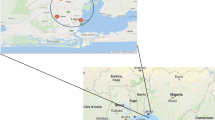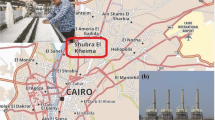Abstract
The main objective of this atmospheric study was to determine the major sources of PM1 (particles having aerodynamic diameter <1.0 μm) within and near the city of Kanpur, in the Indo-Gangetic Plain. Day and night, 10 h long each, filter-based aerosol samples were collected for 4 months (November 2009 to February 2010) throughout the winter season. These samples were subjected to gravimetric and quantitative chemical analyses for determining water-soluble ions (NH4 +, F−, Cl−, NO3 −, and SO4 2−) using an ion chromatograph and trace elements using an inductively coupled plasma–optical emission spectrometer. The mean PM1 mass concentrations were recorded as 114 ± 71 μg/m3 (day) and 143 ± 86 μg/m3 (night), respectively. A significantly higher diurnal contribution of ions (NH4 +, F−, Cl−, NO3 −, and SO4 2−) in PM1 mass was observed during the fog-affected days and nights throughout the winter season, for which the average values were recorded as 38.09 ± 13.39 % (day) and 34.98 ± 12.59 % (night), respectively, of the total PM1 mass. This chemical dataset was then used in a source-receptor model, UNMIX, and the model results are described in detail. UNMIX provided a maximum number of five source factors, including crustal material, composite vehicle, secondary aerosol, coal combustion, and iron/steel production and metallurgical industries, as the dominant air pollution sources for this study.







Similar content being viewed by others
References
Aatmeeyata KDS, Sharma M (2009) Traffic generated non-exhaust particulate emissions from concrete pavement: a mass and particle size study for two-wheelers and small cars. Atmos Environ 43:5691–5697
Artaxo P, Oyola P, Martinez R (1999) Aerosol composition and source apportionment in Santiago de Chile. Nucl Instrum Methods Phys Res 150:409–416
Baxla SP, Roy AA, Gupta T, Tripathi SN, Bandyopadhyaya R (2009) Analysis of diurnal and seasonal variation of submicron outdoor aerosol mass and size distribution in a northern Indian city and its correlation to black carbon. Aerosol Air Qual Res 9:458–469
Begum BA, Biswas SK, Hopke PK (2007) Source apportionment of air particulate matter by chemical mass balance (CMB) and comparison with positive matrix factorization (PMF) model. Aerosol Air Qual Res 7:446–468
Chakraborty A, Gupta T (2010) Chemical characterization and source apportionment of submicron (PM1) aerosol in Kanpur Region, India. Aerosol Air Qual Res 10(5):433–445
Demokritou P, Gupta T, Ferguson S, Koutrakis P (2002) Development and laboratory characterization of a prototype coarse particle concentrator for inhalation toxicological studies. J Aerosol Sci 33:1111–1123
Devi JJ, Gupta T, Tripathi SN, Ujinwal KK (2009) Assessment of personal exposure to inhalable indoor and outdoor particulate matter for residents of an academic campus (IIT Kanpur). Inhal Toxicol 21(14):1208–1222
Foltescu VL, Lindgren ES, Isakson J, Oblad M, Pacyna JM (1996) Gas to particle conversion of sulphur and nitrogen compounds as studied at marine station in Northern Europe. Atmos Environ 18:3129–3140
Gangwar JN, Gupta T, Agarwal AK (2012) Composition and comparative toxicity of particulate matter emitted from a diesel and biodiesel fuelled CRDI engine. Atmos Environ 46:472–481
Gupta T, Demokritou P, Koutrakis P (2004) Effects of physicochemical properties of ultrafine particles on the performance of an ultrafine particle concentrator. Aerosol Sci Technol 38(S2):37–45
Gupta T, Chakraborty A, Ujinwal KK (2010) Development and performance evaluation of an indigenously developed air sampler designed to collect submicron aerosol. Ann Indian Natl Acad Eng (INAE) 3:189–193
Gupta T, Jaiprakash DS (2011) Field performance evaluation of a newly developed PM2.5 sampler at IIT Kanpur. Sci Total Environ 409:3500–3507
Han YJ, Tae SK, Kim H (2008) Ionic constituents and source analysis of PM2.5 in three Korean cities. Atmos Environ 42:4735–4746
Hildemann LM, Markowski GR, Jones MC, Cass GR (1991) Submicrometer aerosol mass distributions of emissions from boilers, fireplaces, automobiles, diesel trucks, and meat-cooking operations. Aerosol Sci Technol 14:138–152
Junker M, Kasper M, Roosli M, Camenzind M, Kunzli N, Monn C, Theis G, Braun C (2000) Airborne particle number profiles, particle mass distribution and particle bound PAH concentrations within the city environment of Basle: an assessment of the BRISKA Project. Atmos Environ 43:3171–3181
Kang C-M, Gupta T, Ruiz PA, Wolfson JM, Ferguson ST, Lawrence JE, Rohr AC, Godleski J, Koutrakis P (2010) Aged Particles Derived from Emissions of Coal-fired Power Plants: The TERESA Field Results. Inhal Toxicol 23(S2):11–30. doi:10.3109/08958371003728040
Kaul DS, Gupta T, Tripathi SN, Tare V, Collett JL (2011) Secondary organic aerosol: a comparison between foggy and non-foggy days. Environ Sci Technol 45:7307–7313
Kleeman MJ, Cass GR (1998) Source contributions to the size and composition distribution of urban particulate air pollution. Atmos Environ 32:2803–2816
Kumar R, Srivastava SS, Kumari KM (2007) Characteristics of aerosols over suburban and urban site of semiarid region in India: seasonal and spatial variations. AerosolAir Qual Res 7(4):531–549
Kumar A, Sarin MM (2009) Mineral aerosols from western India: temporal variability of coarse and fine atmospheric dust and elemental characteristics. Atmos Environ 43:4005–4013
Larsen IRK, Baker JE (2003) Source apportionment of polycyclic aromatic hydrocarbons in the urban atmosphere: a comparison of three methods. Environ Sci Technol 37:1873–1881
Lee JH, Hopke PK (2006) Apportioning sources of PM2.5 in St. Louis, MO using speciation trends network data. Atmos Environ 40:360–377
Lin JJ, Lee LC (2004) Characterization of the concentration and distribution of urban submicron (PM1) aerosol particles. Atmos Environ 38:469–475
Maykut NN, Lewtas J, Kim E, Larson TV (2003) Source apportionment of PM2.5 at an urban IMPROVE site in Seattle, Washington. Environ Sci Technol 37:5135–5142
Mehta B, Venkataraman C, Bhushan M, Tripathi SN (2009) Identification of sources affecting fog formation using receptor modeling approaches and inventory estimates of sectoral emissions. Atmos Environ 43:1288–1295. doi:10.1016/j.atmosenv.2008.11.041
Mukerjee S, Norris GA, Smith LA, Noble CA, Neas LM, Ozkaynak AH, Gonzales M (2004) Receptor model comparisons and wind direction analyses of volatile organic compounds and submicrometer particles in an arid, binational, urban air shed. Environ Sci Technol 38:2317–2327
Munger JW, Jacob DJ, Waldman JM, Hoffmann MR (1983) Fogwater chemistry in an urban atmosphere. J Geophys Res 88:5109–5123
Pandis SN, Seinfeld JH (1989) Sensitivity analysis of a chemical mechanism for aqueous-phase atmospheric chemistry. J Geophys Res 94:1105–1126
Raes F, Dingenen RV, Vignati E, Wilson J, Putaud JP, Seinfeld JH, Adams P (2000) Formation and cycling of aerosols in the global troposphere. Atmos Environ 34:4215–4240
Sanhueza E, Rondon A (1988) Particle-size distribution of inorganic water soluble ions in the Venezuelan savannah atmosphere during burning and nonburning periods. J Atmos Chem 7:369–388
Schauer JJ, Rogge W, Hildemann LM, Mazurek MA, Cass GR, Simoneit BRT (1996) Source apportionment of airborne particulate matter using organic compounds as tracers. Atmos Environ 30:3837–3855
Seinfeld JH, Pandis SN (1998) Atmospheric chemistry and physics. Wiley, New York, 15:793–801
Sharma M, Kishore S, Tripathi SN, Behra SN (2007) Role of atmospheric ammonia in the formation of inorganic secondary particulate matter: a study at Kanpur, India. J Atmos Chem 58:1–17
Shen Z, Cao J, Arimoto R, Han Y, Zhu C, Tian J, Liu S (2010) Chemical characteristics of fine particles (PM1) from Xi’an, China. Aerosol Sci Technol 44:461–472
Shen Z, Cao J, Tong Z, Liu S, Reddy LSS, Han Y, Zhang T, Zhou J (2009) Chemical characteristics of submicron particles in winter in Xi’an. Aerosol Air Qual Res 9:80–93
Singh RP, Dey S, Tripathi SN, Tare V (2004) Variability of aerosol parameters over Kanpur City, Northern India. J Geophys Res 109:D23206. doi:10.1029/2004JD004966
Singh VP, Gupta T, Tripathi SN, Jariwala C, Das U (2011) Experimental study of the effects of environmental and fog condensation nuclei parameters on the rate of fog formation and dissipation using a new laboratory scale fog generation facility. Aerosol Qual Res 11(2):140–154
Srivastava A, Gupta S, Jain VK (2008) Winter-time size distribution and source apportionment of total suspended particulate matter and associated metals in Delhi. Atmos Res 8:188–200
Stokes A (1954) Uptake and translocation of griseofulvin by wheat seedlings. J Plant Soil 5:132–142
Tare V, Tripathi SN, Chinnam N, Srivastava AK, Dey S, Manar M, Kanawade VK, Agarwal A, Kishore S, Lal RB, Sharma M (2006) Measurement of atmospheric parameters during Indian Space Research Organization Geosphere Biosphere Program Land Campaign II at a typical location in Ganga Basin: 2. Chemical properties. J Geophys Res 111, D23210 (1–14). doi:10.1029/2006JD007279
Wang Y, Zhuang GS, Sun YL, An ZS (2006) The variation of characteristics and formation mechanisms of aerosols in dust, haze, and clear days in Beijing. Atmos Environ 40:6579–6591
Willison MJ, Clarke AG, Zeki EM (1985) Seasonal variation in atmospheric aerosol concentration and composition at urban and rural sites in Northern England. Atmos Environ 19:1081–1089
Willison MJ, Clarke AG, Zeki EM (1989) Chloride aerosols in Central Northern England. Atmos Environ 23:2231–2239
Zhang W, Sun YL (2006) Characteristics and seasonal variations of PM2.5, PM10, and TSP aerosol in Beijing. Biomed Environ Sci 19:461–468
Author information
Authors and Affiliations
Corresponding author
Additional information
Responsible editor: Gerhard Lammel
Electronic supplementary material
Below is the link to the electronic supplementary material.
ESM 1
(DOCX 75 kb)
Rights and permissions
About this article
Cite this article
Gupta, T., Mandariya, A. Sources of submicron aerosol during fog-dominated wintertime at Kanpur. Environ Sci Pollut Res 20, 5615–5629 (2013). https://doi.org/10.1007/s11356-013-1580-6
Received:
Accepted:
Published:
Issue Date:
DOI: https://doi.org/10.1007/s11356-013-1580-6




